#herbivory
Photo
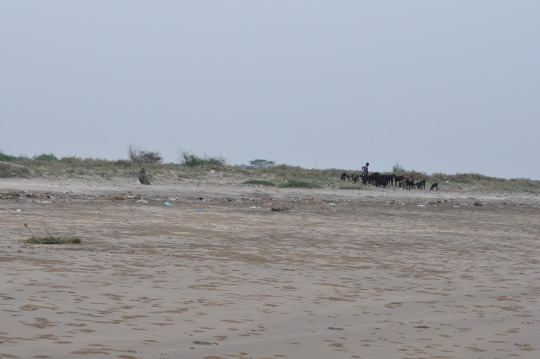

The tropical seashores here provide a reliable and steady livelihood for shepherds and buffalo herders, a reliable source of milk and income.
One would have thought that given the hostile environment they inhabit, of desiccation, heat and perhaps even serpentine soils not to mention the osmotic stress of excessive salt, beach vegetation would arm itself with toxic secondary metabolites to avoid herbivory, since it would be expected to lack the anabolic resources needed to regenerate lost leaves.
Such however does not seem to be the case. While there are some toxic plant species - such as Calotropis procera - here, these seem to be the exception than the rule, for the sparse vegetation actually supports a considerable population of domesticated herbivores - buffaloes and sheep - they essentially using their maws and mouths to contentedly and leisurely scythe their way up and down the seashore, the regenerative powers of beach vegetation actually quite impressive.
Machilipatnam Beach, July 19, 2019.
#herbivory#herbivores#sheep#shepherds#buffalo#domesticated#calotropis procera#herders#coastline#seashore#coast#Coastal Andhra#andhra pradesh#secondary metabolites#osmotic stress#desiccation#regeneration#livelihood#allelochemicals#machilipatnam#beach#plant ecology#scythe#milk#serpentine#soils#heat stress#water stress#beach vegetation#extreme environment
2 notes
·
View notes
Text
Subterranean Wonders: The Fascinating Resilience of African Geoxyles
Geoxyles, a distinctive feature of Afrotropical savannas and grasslands, are a type of tree that survives recurrent disturbances by resprouting from large belowground woody structures. A new study by Anya Courtenay and colleagues, published in Annals of Botany, found that underground trees inhabit significantly distinct and extreme environments relative to their taller, woody tree/shrub…

View On WordPress
0 notes
Text
This hypothesis was recently confirmed by a study of the interactions between Arabidopsis and cabbage looper (Trichoplusia ni), a generalist lepidopteran herbivore (Figure 23.24A). (...) To test whether the plant circadian clock enhances defense against insect pests, herbivory was compared in Arabidopsis plants whose jasmonate-mediated defense responses were either in phase (Figure 23.24B) or out of phase (Figure 23.24C) with the circadian rhythm of cabbage looper feeding activity. After allowing cabbage loopers to feed freely on the plants for 72 h, plants whose defense responses were in phase with the loopers had visibly less tissue damage than plants whose circadian rhythm was out of phase with that of the insects (Figure 23.24D). As a result, cabbage loopers that fed on the phase-shifted Arabidopsis plants gained three times as much weight over the same period as the synchronized control plants did (Figure 23.24E).
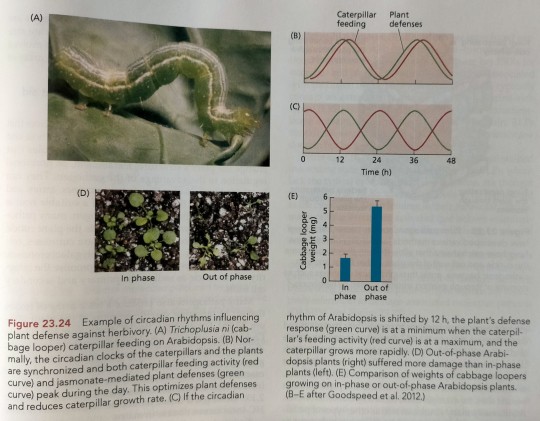
"Plant Physiology and Development" int'l 6e - Taiz, L., Zeiger, E., Møller, I.M., Murphy, A.
#book quotes#plant physiology and development#nonfiction#textbook#arabidopsis#cabbage looper#caterpillar#trichoplusia ni#circadian clock#herbivory#jasmonate#circadian rhythm#insects#in phase#out of phase#synchronized#phase shift
0 notes
Text
I wanna make a Therian themed cookbook so bad some day. Would that even be doable as a community project. Yes it's so I can ramble about ways to eat raw meat and bugs again.
#probably not including fictionkin bc that'd be a bit harder#my idea is more... based on carnivory herbivory scavenging etc#how to replicate diets human can't quite follow#otherkin#therian
77 notes
·
View notes
Text

Herbivorial: A gender that is itself herbivory / herbivore.
[ Tag List: @ophelia-thimgs, @liom-archive, @hoardicboy-main, @radiomogai, @acidicwolf16 ]

#draedons arsenal : coining post#mogai#mogai identity#mogai label#mogai blog#mogai coining#mogai term#liom#liom term#liom label#liom coining#coining post#flag coining#identity coining#mogai gender#gender coining#liom gender#xenogender#neogender#herbivorial
12 notes
·
View notes
Note
so wait, the one thing keeping the tree kangaroo from being classified as a mammal is that its a herbivore? fascinating
yes exactly!
#though some mammals eat a lot of plants they are referred to as ‘vegetarians’ and this is astronomically different from herbivory#asks#trashpaintedgold
6 notes
·
View notes
Text
The relationship between rakii and animals is fairly utilitarian. If it's not useful, it's not worth the care, making having pets vastly unpopular. Some favored livestock mainly among the temperate regions are Bwree.
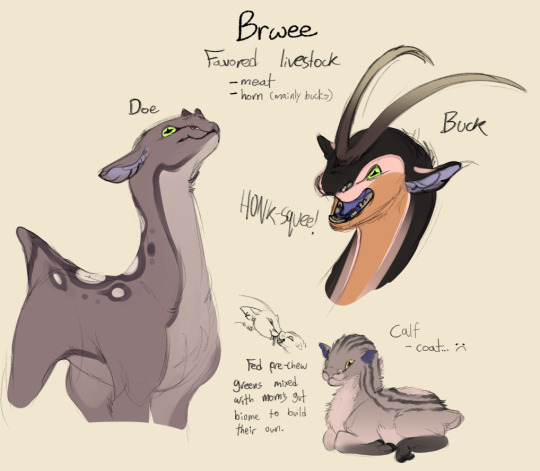
They are domesticated herbivories the rakii range for meat and the horn as they were useful for tool material and decoration. The brwee does are for meat and calves, which they can have up to three or four of. Brwee calves are born with a fluffy stripe patterned coat, which is useful for leather linings and insulation for boots and coats. And of course, meat. While Bwree may protect their young, the does are pretty r-selective as they will only feed and care for the strongest calves in her group. The average ditching 1 or 2 of their litter, which the rakii make use of.
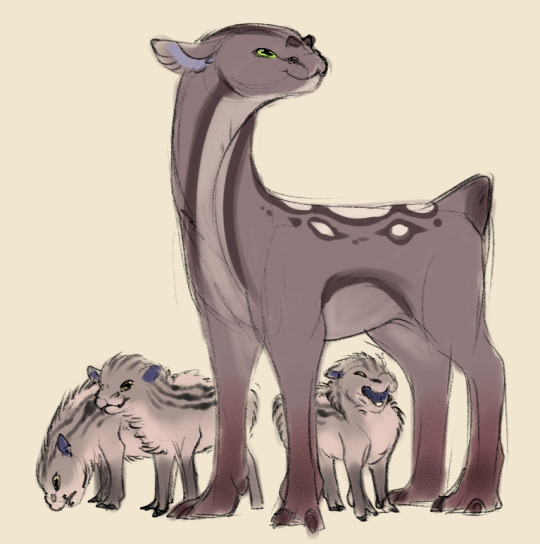
And for the many they have, they use the help of tamed quabuas to herd them. Their hunting tactics and pack bonds became useful for the rakii around 15,000 years ago, so it's a fairly new development. However, wild quabua will often try to "test the pecking order" and tend to challenge the pack lead. Making them difficult as pets.

295 notes
·
View notes
Text
Spectember/Spectober 2023 #11: A Large Spider
An anonymous submission requested a "spider the size of a coconut crab":
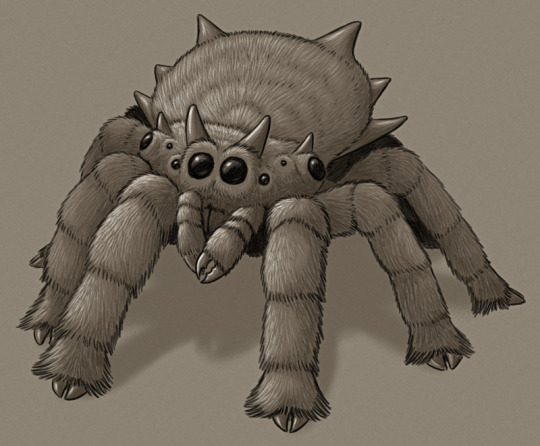
Ceratohispidus aspectus is a distant descendant of jumping spiders living on an Aotearoa-like landmass, isolated with no mammalian predators.
This particular lineage is notable for both their extreme gigantism (with their larger size and weight causing them to lose the ability to jump) and for having taken up herbivory in a similar manner to one modern species. Most of these big plant-eating spiders are around the size of wētāpunga, and occupy a similar ecological niche, but Ceratohispidus is the largest of them by far – rivalling the modern coconut crab with a body length of up to 40cm (~1'4") and a legspan of almost 1m (~3'3").
After reaching sexual maturity at 5-10 years old, adults grow very slowly, molting only once every year or two and taking several decades to actually get anywhere close to their maximum size.
Ceratohispidus' thick legs end in hoof-like claws, and it selectively browses on vegetation by snipping off pieces with its pincer-like palps. A gizzard-like structure in its digestive system helps to grind up fibrous plant material with small gastroliths, and its wide abdomen houses both large book lungs and a tracheal system with air sacs that can contract and expand to provide a small amount of active ventilation.
While the "horns" and spikes ornamenting its body may provide some defense from the few avian and reptilian predators in its habitat, they're mainly used as part of highly elaborate visual displays between individuals.
#spectember#spectober#spectember 2023#speculative evolution#arachnophobia tw#jumping spider#spider#arachnid#arthropod#invertebrate#art#science illustration#happy halloween#have a little hint of carcinization. as a treat
341 notes
·
View notes
Note
Tell me more about parasites and their hosts. Do you think the dynamic works if neither is aware of the other?
Before all else, any simplified dynamic has nigh infinite potential and how you explore it depends entirely on what you personally are looking for.
In my own case, a lot of my relationship with the idea of parasitism comes from my own mental health being strongly dependent on where I live- being able to return to home like a save point in a horror game. This sense of constantly being dependent on comfort, not merely as a normal person is but to the extent that I've felt like I'll be unable to cope if I can't get home in time or haven't built adequate mini 'safe rooms' (e.g. my car or a hotel room) to recharge, has formed a lot of my relationship with the idea of parasitism and the idea of haunted houses.
Both, to me, centrally focus on the idea of dependency on equilibrium. A house can't really chase you down- while there's certainly haunted house stories that give it the power to trap or pursue, to me, the most compelling angle is often one of necessity. Someone weighing the ghosts, the violence, the blood on the walls, and having to ask themselves if this is really worse than being homeless, or losing some advantage or shelter that you have here that can't be found elsewhere.
In the case of parasitism, the host is the haunted house. It may be simply indifferent to the parasite's survival; it may be actively hostile to and trying to rid itself of the 'guest'. But both parties have to weigh the odds- is it worth tearing into your own walls just to get at the interloper, is it worth staying in a place that unknowingly tolerates your existence at best and hates you at worst if the alternative is being laid barren in the world?
As a child, I remember reading the Animorphs books and one thing that always struck me as an unexpected source of pathos was how bleak and miserable the yeerks' default existence was. While we mostly experienced them from the horror of their would-be victims, people terrified and paranoid that those around them were being controlled, made prisoners in their own minds... the book where Cassie is briefly host to a yeerk and the first thing said yeerk does is, rather than focus on their agreement or advantages, start running around wildly and making use of Cassie's morphing power for the sheer wild euphoria of being able to.
As much as they are the Bad Guys in the story- invaders, body snatchers, sometimes sadists- there's something to be said about the torture of a fully sapient and intelligent being living as a nearly senseless, barely mobile creature by default. A tapeworm is perhaps lucky it cannot evaluate its existence in comparison to other life forms.
And, yeah, sure, parasites trip a particular contrarian reflex in me that I always want to root around and play with things that are seen as too icky or evil to be 'worth exploring', whether or not there's even any actual morality attached to things. Parasites do nothing on a basis of sadism- 'parasitism' is how they survive just as much as herbivory is how a rabbit survives.
It's instead on a basis of need.
And the point where we need others- especially imperfectly, reluctantly, warily, always hesitating on these dynamics of exploitation- and especially when it comes to the body which we often see as the most private bastion of the self- is where some really juicy dynamics can spring from.
#writing ruminations#long post#do I need you; do you need me; can I not live without you; is this not a form of devotion; is this not a form of love;#I am not the same as I was before I met you before you touched me; there is 'Us' now and it is beautiful and horrid;#we dread 'Us' as much as we dread the solitary 'I'- the true proof that we are alone
86 notes
·
View notes
Text
Fossil Novembirb 5: It's Getting Hot In Here

Sandcoleus by @drawingwithdinosaurs
Global warming is nothing new for the planet, and even in the Cenozoic we've had our share of rapid warming events - the most notable one being the Paleocene-Eocene Thermal Maximum (PETM). This event, taking place 56 million years ago, was the result of rapid carbon release from the North Atlantic Igneous Province - aka, a volcano exploded, released a bunch of greenhouse gases, and suddenly global temperatures jumped somewhere between 4 and 10 degrees Celsius (depending on location) in a very short period of time - sound familiar?
Given the obvious parallels to the current day, this event has been studied extensively, though only in a few spheres. We know that plants changed dramatically, with broad leafed plants spreading around the world and turning it into a global tropical forest, even at the polls - leading to interesting adaptations towards the strange light cycles at high latitudes. The world was wetter, and greener, and the change lead to the evolution of new herbivory methods in insects. Mammals got smaller, spread everywhere, and diversified. A mass extinction occurred in the oceans, with microorganisms seeing a larger drop in diversity than during the end-Cretaceous extinction. More calcified algae flourished in the more acidic waters.
But what happened to birds?
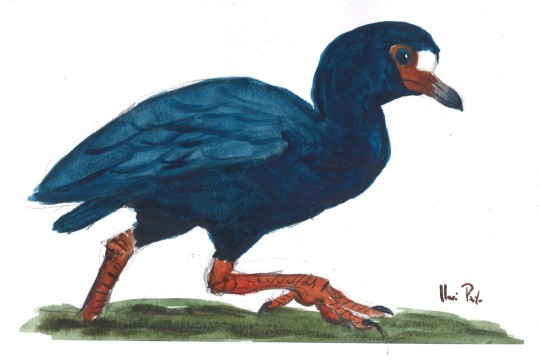
Anachronornis by @otussketching
Turns out, we're not quite sure. Bird fossils before the event are rare, and after are so diverged and varied that it's difficult to know what happened because of the event, and what happened before and just didn't fossilize. Luckily, scientists (... me) are on the case! And there were a few ecosystems that straddle the time around the event, such as the one for this post: the Willwood Formation.
This ecosystem in Wyoming takes place over the late Paleocene through the early Eocene, covering the entire PETM period. And while it showcases many different aspects of this transition, we're of course here for the birds! Not only was there Gastornis, because it was a ubiquitous presence in the Northern Hemisphere following the PETM, there were also many other weird early kinds of birds, all across the avian family tree.

Paracathartes by @drawingwithdinosaurs
Sandcoleus is one of the more notable tree birds from this ecosystem, being a relative of living mousebirds but in North America (rather than Africa, where they are found today). In fact, lots of different tree birds were present, indicating that the current dominance of Passeriformes - so called "perching birds" - was not always the case. In fact, Paracathartes was also present - our first Palaeognath, an early Lithornithid! - and it also may have been able to perch in the trees, and certainly seems to have been a decent flier.
There were also Geranoidids like Palaeophasianus and Paragrus, which were once thought of as pheasant-like and crane-like respectively, but may now actually be Palaeognaths - and some of the earliest known flightless ones to boot! That said, said, other than being long legged flightless birds, we know little about their ecologies - they may have been herbivorous, and as tropical forest dwellers, could have had similar lifestyles to the living cassowary.
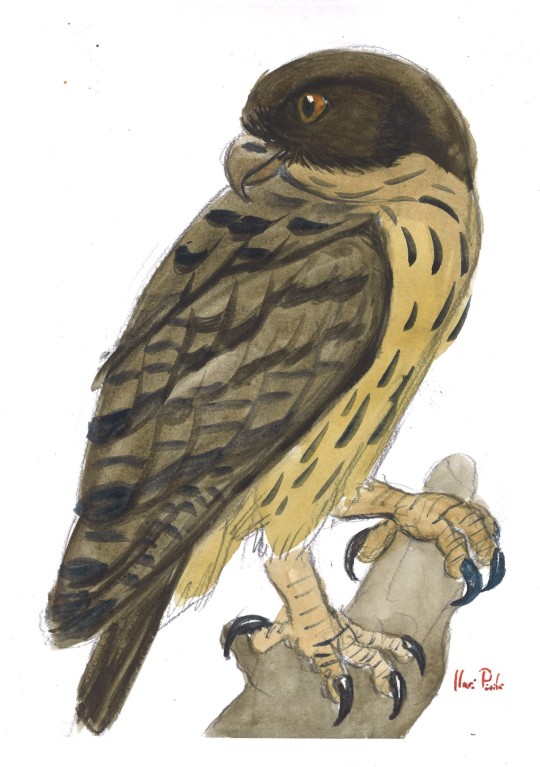
Primoptynx by @otussketching
And, of course, there was also Anachronornis, the half-screamer-half-duck thing, showcasing how waterfowl were experimenting with a variety of different niches during this ecological explosion. And the large variety of new small mammals didn't go unnoticed either - while other early owls are known from Europe, Primoptynx was both the oldest and the biggest, probably thanks to all the new small mammals to eat! There were also possible ground raptors, similar to Bathornis, though they have not been named.
While there are many questions left to answer, it is clear that the PETM had a major effect like it did on everything else on the planet during that time - and the tropical ecologies that they evolved in during the early Eocene would have many implications, especially for where different clades live today!
Sources:
Houde, P., M. Dickson, D. Camarena. 2023. Basal Anseriformes from the Early Paleogene of North America and Europe. Diversity 15 (2): 233.
Mayr, 2022. Paleogene Fossil Birds, 2nd Edition. Springer Cham.
Mayr, 2017. Avian Evolution: The Fossil Record of Birds and its Paleobiological Significance (TOPA Topics in Paleobiology). Wiley Blackwell.
104 notes
·
View notes
Text

Wanted to prioritize a Spectober/Spectember post before getting to asks.
The masaka share their evolutionary tree with countless species of four-legged (sometimes two legged) small invertebrates, adapted to all sorts of ecological niches. They have their brains and eyes on their posterior side, and the cephalothorax with mouth on their anterior.
Donelja's a big fan. Their career in desert conservation on the terraformed masaka moon largely involves studying how the insects are doing (insect herbivory, population surveys ect.)
#selkra scribbles#my art#brokenyolkgalaxy#broken yolk galaxy#masaka taxonomy#donelja#alien#speculative biology#worldbuilding#xenofiction#speculative zoology#xenobiology#astrobiology#spectober#spectember#spectember 2023
73 notes
·
View notes
Note
what do thrones eat? the big ones look like they take a lot of feeding. do the bird body ones eat bird food?
Thrones do, in fact, eat a lot. It depends a lot on their bodies, but most are largely omnivorous. Since being able to stomach a greater variety of foods means more things are then available to stomach. Throne bodies are also largely cosmetic, so they might not need to eat like the animal they most closely resemble. The Thrones of Sevab House have serpentine bodies, but don't eat all that differently than the beast-footed Thrones. The body-shape they have does usually come with practical concerns that influence things like diet, though. The beast-footed houses, take Dedēsne House as a good example, eat more wild game than the serpentine Thrones of Sevab House, because there's more of a culture of nobles going on hunts there, while Sevab's Thrones are more expected to drape themselves elegantly about and have clever things to say. They still might be designed with dietary preferences for cultural reasons, i.e., a house that follows a branch of religion that practices vegetarianism not being capable of eating anything other than plants - which is also in line with the fact that Thrones are held by their communities to higher standards of religious conformity, they are Holy Beasts after all. This mostly applies to Thrones with ruminant-like bodies, where the herbivory is symbolically significant. This would also come with the expected Ruminant Issues, though, so that's a thing.
The Lujnola Thrones are an interesting case, however, because their bodies are designed to be more practical than average, and some of the restrictions of real birds also extend to them. You won't find any adapted to eat leaves (no stinky hoatzin Thrones alas). The Lujnola Thrones eat fruit more than anything else. It makes up probably 70 or 80% of their diets, with some meat thrown in. The meat is quite varied, though. They do hunt and especially trap wild game, but like to eat animals - lizards, turtles, frogs, insects, and smaller mammals like rodents and tiny forest deer. They do have some livestock, big meaty snails, and certain woodboring insects with large grubs are generally popular in the eastern empire. The most unique livestock Lujnola has is a species of arboreal, golden-furred rodent that's often eaten on special occasions. There are quite a lot of spiritual cleanliness practices around hunting and the use of weapons specifically, which is actually a bit of a point of prejudice the Throne-Lords of the region have against their non Throne subjects, who hunt game like deer, boars, and forest cattle. None of the Thrones ever hunt large game, and they don't eat bird meat out of principle, at least not in Lujnola Province, traveling Thrones of the house wouldn't always turn bird meat down, fowl just arent hunted or kept as livestock back home. That isn't because "it's cannibalism", they just have a huge respect and reverence for birds in general. They do like eggs, though. A lot of rituals and "magical" practices involve eating bird eggs, and different species of bird are said to embue their eggs with different properties - cleverness from a Jay, bravery from a hornbill, love from a parrot, etc.
-
Also, because Throne bodies are so large, the mouth of their "head"/human portion is not adequate to feed them, which is why most Thrones have secondary, more proportionate mouths. Have an old doodle of a guy having a snack.
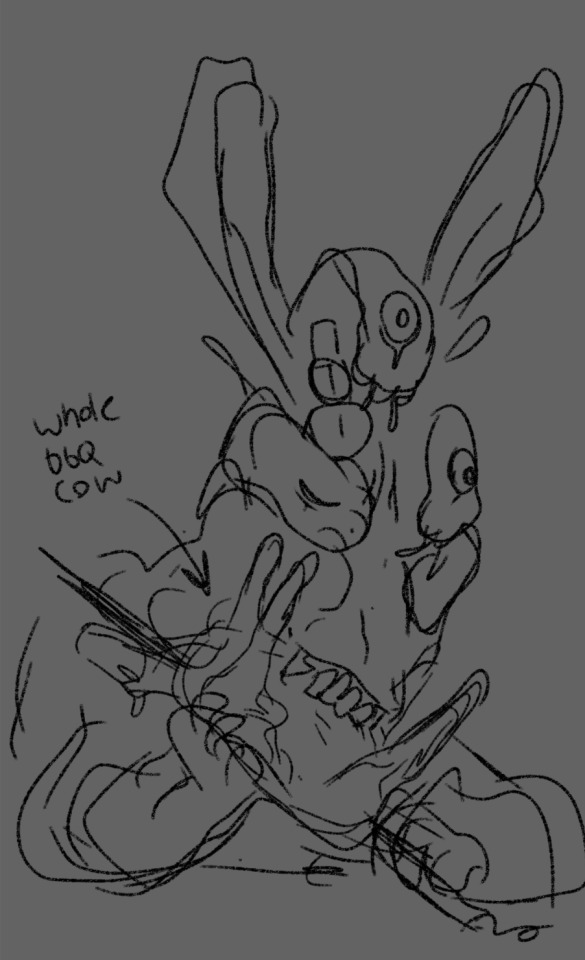
#im assuming this is someone from the discord Hi#since its not sent to the blog i post art on + timing#migt do better illustrations for this later.
73 notes
·
View notes
Text

REUPLOAD hihihaha because i fucked up a lil.anyway sheep in a binder aka my um. beastarsona i guess. which is a fancier word for a fursona
im rlly into the uhh unhinged prey animal frantically frustrated and dissatisfied with his herbivory trope.and seeking that sort of satisfaction or release from the bounds of his 'prey animalness' from predator animals...aka he fucks carnivores or something lmao. actually its probably more psychological but still. when i say he i mean i, im him
#anyway this is what i look like irl actually#i assume that in a world where we r all animals horned mammals would wear jewellery in their horns/antlers aswell#as would i#my art
18 notes
·
View notes
Text


Finally found a paw paw tree on Campus!
Asimina Triloba - aka the Paw Paw is North America's largest indigenous fruit typically found throughout Appalachia, the eastern Midwest, the Ozarks and reaches as high north as southern Ontario. The tree itself is closely related to the custard apple, the flavor of the fruit is very similiar to banana/papaya/persimmon. Although people often rave about this amazing fruit you cannot find it in stores, quite like many forgotten foods, they only last about a week. This short life span makes trasnport difficult and cuttings are almost impossible to propagate. Essentially, all new Paw Paws must be grown from seed or transplanted from young seedlings, making consistency of a cultivar questionable.
The plant itself requires very little light making it one of the rarer understory fruiting trees. Ecologically the seeds/bark/leaves/and roots all contain a natural insecticide so the tree is rarely subject to herbivory. The most common method of propagation is clonally via root sprouts. Historically fruit was consumed by megafauna, however with most species absent in its range new plants rely on bears and human distribution.
All this being said it is a wonderful fruit which has a variety of uses, nutritionally very high in manganese and iron. You can eat paw paws raw or use the pulp in baking recipes similiar as you would a banana (I know a farmer who loves making ice cream with the fruit). Keep an eye out for them! They're not endangered and could use some attention to reenter our local food systems!
#paw paw#asimina triloba#urban forage#the really remind me of persimmon in flavor and seed shape tbh
54 notes
·
View notes
Note
Jack, have you considered herbivory?

#dsaf#dayshift at freddy's#ask blog#ask#art#dsaf art#dsaf fanart#dsaf jack#dsaf old sport#old sport#dsaf jack kennedy
29 notes
·
View notes
Note
So are humans actually herbivore?
No, we’re definitely not. The argument that we are, pointing to our canines or our long intestinal tract as evidence of herbivory is based on some pretty fundamental misunderstandings about what these terms mean and what is involved in adaptation. Besides, I think it’s totally irrelevant and vegans are making a mistake by engaging in quite so many conversations about this.
The herbivore/omnivore divide is a pretty simplistic, arbitrary species categorisation. It’s a helpful way for us arrange species in groups but it’s not especially meaningful even in purely biological terms, and it certainly isn’t meaningful in ethical terms. If we were ‘supposed’ to be herbivores (whatever that even means), that would in no way strengthen the argument for veganism, just as us being omnivores doesn’t weaken it.
These labels are helpful for determining whether we can eat animals, not whether we should be eating them, which is an ethical question rather than a scientific one. Its just not a subject that has any relevance for conversations about the ethics of eating animals.
27 notes
·
View notes